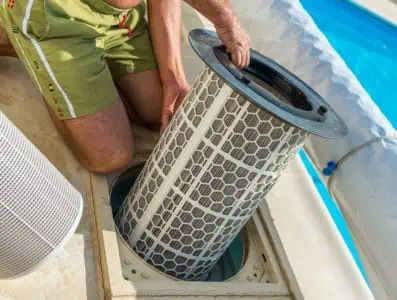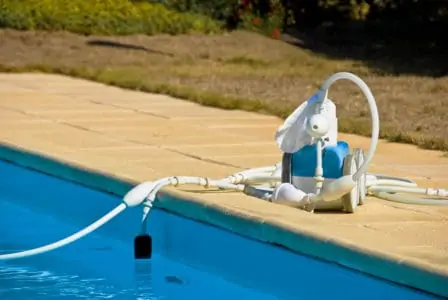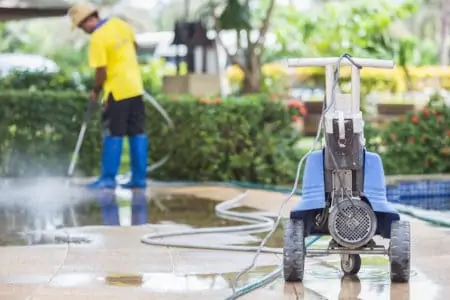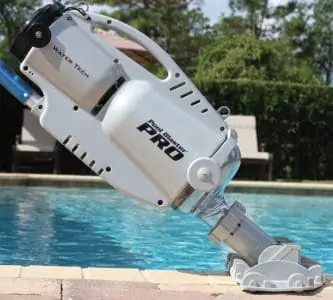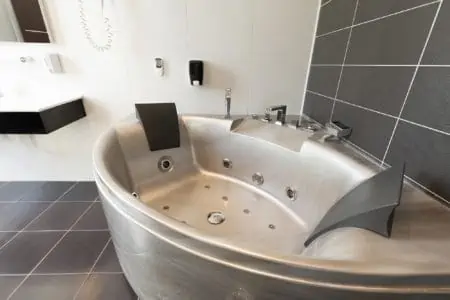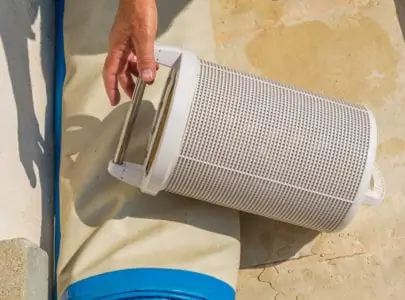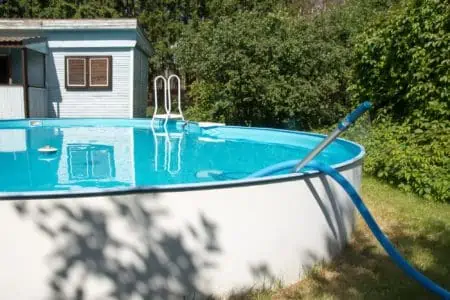If you have a pool, then you want your pool water to be clean, clear, and healthy so your family can enjoy swimming. The pool filter cartridge is an important part of keeping your swimming pool’s water clean. The cylindrical fan-folded polyester cartridge allows water to flow through the fabric trapping any debris or algae that may have appeared in your pool.
Unfortunately, it doesn’t last forever and will need to be cleaned regularly. So here’s how to clean a pool filter so you can maintain a clean and healthy pool all summer.
Key Takeaways
- Clean pool filter cartridge every 3-6 months or when PSI gauge reads 8-10 PSI above its last cleaning level.
- Remove the cartridge, spray with a garden hose, and deep clean if necessary with vinegar, dishwasher detergent, or muriatic acid.
- Inspect cartridges for damage; replace if torn, cracked, or mushy.
- Maintain your pool by regularly removing debris, checking chemical levels, and using algaecide to prevent algae growth.
How Often Should I Clean My Pool Filter Cartridge?
A pool filter cartridge should be cleaned every 3-6 months to remove all the debris and dirt that has been caught. Another way to tell if your pool filter needs to be cleaned is when the PSI gauge reads 8-10 PSI above what it was after the last cleaning.
How to Clean a Pool Filter Cartridge
Cleaning a pool filter cartridge will remove the debris and dirt that it’s caught over the last few months. You begin by removing the pool cartridge and then spraying it with a hose to remove the debris. If it’s extremely dirty, you’ll need to give it a deep cleaning before you replace it in the filter tank.
- Time: 30 minutes – overnight
- Difficulty: Intermediate
What You’ll Need
- Garden hose
- Spray nozzle
- Owner’s manual
- Large bucket or trash can
- Vinegar, dishwasher detergent, or muriatic acid
- Measuring cup
- Protective equipment if using muriatic acid
- Non-petroleum based lubricant
1. Turn Off The Pump
You will need to turn the pump off at the breaker and then close all the pump’s inlet and outlet valves. Open the air-relief valve at the top of the tank by turning it to the open position. This will prevent you from accidentally opening the tank while it’s under pressure which could harm you or the tank.
2. Open the Filter Tank
You will first open the housing of the tank. Remove the clamp holding the tank together. Most tanks use an O-ring these days, but it could also be held together by a bolt. Press up on the release tab and turn counter-clockwise to open the housing.
Check your owner’s manual for specific directions for your tank if you’re not sure how to open it.
Once the housing is open, remove the top of the filter.
3. Remove Filter Cartridges
Remove all the cartridges you see in the tank as it may contain between 1 and 4 of the filter cartridges. If the filter cartridges are not coming out easily, you may need a rocking motion to loosen the cartridges enough to remove them. Double-check your owner’s manual first though to check if there are any attachments holding them in place.
4. Inspect the Cartridges
Inspect the cartridges before proceeding. Look to see if a cartridge is mushy, torn, cracked, or any other signs of damage. If you see any signs of damage, the cartridge will need to be replaced with a new cartridge.
Place the cartridges on the grass after you’ve inspected them. This way the debris will go directly into the lawn making it easier to clean up after you’ve finished cleaning the cartridges.
5. Spray with a Hose
A garden hose and spray nozzle make a simple cleaning tool to hose off the cartridges. Do your best to maintain a 45-degree angle to prevent damaging the cartridges and work from the top to the bottom. Your goal is to remove all the debris between the pleats.
Do not use a pressure washer to clean the cartridges as the pressure will damage the fabric of the filter. You can brush the pleats off to remove any small particles that refuse to come off with the sprayer.
6. Rinse and Clean the Filter Housing
Rinse and clean the filter housing while the cartridges are soaking in the solution of your choice.
7. Replace in Housing
After you’ve rinsed the cartridges, return them to the filter housing. Then fasten them into place and put the top of the housing back on the filter tank. Check to be sure everything is fastened into place.
8. Check O-Ring
Now you will need to check the o-ring to be sure it’s in good shape. If so, lubricate it. If not, you will need to replace it.
9. Turn On System
Turn the system back on and make sure the air relief valve is open. Leave it open until a steady stream of water is spraying out of it. Next, close the valve and double-check the pressure gauge to be sure it’s returned to the normal range.
If the pressure gauge hasn’t returned to the normal range, check the owner’s manual to troubleshoot and solve the issue.
10. Test Filter’s Air Pressure
Write down the pressure on the gauge. You will need to know the starting pressure so you can tell when your filter cartridges will need to be cleaned again.
How to Deep Clean a Pool Cartridge Filter
Deep cleaning of the pool cartridge filter is when you soak the pool cartridge in one of the above solutions for 3+ hours or overnight. You will need to soak the cartridges when the pool cartridges aren’t cleaned by hosing them down. After completing step 5 above which is hosing down the cartridges, you may find that the cartridges aren’t clean enough. If this is the case, you will need to soak or deep clean the cartridges.
Now, the cartridges need to be deep cleaned to remove the last of the stains, dirt, and oils on them. To do this, soak the cartridges in one of the following solutions.
When the soaking is finished, you will need to return to step 6 above and rinse the filter housing.
With Vinegar
The acidity in vinegar does a great job in removing any calcium or mineral buildup in the filters. So vinegar is a great DIY solution to use when deep cleaning your pool filters.
1. Mix Vinegar and Water
Mix a 1:1 concentration of white vinegar and water in a large bucket. You’ll need at least ½ gallon of vinegar and a ½ gallon of water in order to have enough of the mixture to completely cover the pool filters.
2. Soak
Soak the pool filters for at least 3 hours or even overnight before you remove them from the vinegar and water mixture.
3. Rinse the pool filters.
Rinse the pool filters thoroughly before you rinse the filter housing.
With Dishwasher Detergent
You can make a homemade cleaner to clean your pool filters by using dishwasher detergent or dish soap. It’s best to choose a detergent or soap that doesn’t create many suds.
1. Mix Solution in Bucket
You will add 1 cup of dishwasher detergent for every 5 gallons of water you use. Mix the solution thoroughly in a large bucket or trash can.
2. Soak
Add the filters to the solution and soak for 10 hours.
3. Rinse
After 10 hours, remove the filters and make sure that you rinse the filters very well to remove all of the soap.
With Muriatic Acid
Muriatic acid can also be used to clean your pool filters, especially if they’re covered with algae. The acid wash will help to kill the algae.
Safety Note
Always add the acid to the water and never add water to the acid. Mixing water and acid will create hydronium ions which will spit and splash when concentrated. This may cause chemical burns if any of the acid lands on your skin.
1. Make the Acid Solution
Make the muriatic acid solution by adding 1 part muriatic acid to 20 parts water. Add the appropriate amount of water to a large bucket or trash can. Then add the muriatic acid to the water.
2. Place Filters in the Acid
Place the filters into the acid. When the bubbling stops, pull out the filters using the appropriate protective equipment.
3. Rinse
Rinse the filters.
Pro Tip
Bleach is not recommended for cleaning cartridge filters as the bleach can damage the fibers of the cartridge. This will shorten the life of your pool cartridges.
How Do You Clean Algae Out of a Pool Filter Cartridge?
The best way to clean algae out of the pool filter is by using a muriatic acid solution or even soaking the filters overnight in TSP. TSP is trisodium phosphate. There are several different brands, however, Savogran Trisodium Phosphate sells a box of trisodium phosphate which also comes with Centaurus AZ Resistant Gloves to protect your hands.
If the muriatic acid did not work to remove the algae or if you prefer to use TSP, you can add 1 cup of TSP to 5 gallons of water. Soak the filters overnight. Then rinse them thoroughly in the morning.
To prevent algae from growing in your pool filter cartridge, it’s important to keep your pool clean. Leaves and debris add phosphates to your pool which feed the algae. Remove the debris and use a phosphate remover like Clorox’s Pool & Spa Phosphate Remover.
Also, add an algaecide like Super Algae Guard Swimming Pool Algaecide Cleanser. It will kill any algae spores before they can bloom.
How Long Does a Pool Filter Cartridge Last?
Most pool filter cartridges will last 3-4 years under normal usage. However, you will need to replace them when they are torn, cracked, mushy, or damaged in any way.
Pool Filter Maintenance Tips
There are a few things you can do to help maintain your pool filter for longer.
- Add a tennis ball to your pool. It will absorb oils that will clog up the filter.
- Remove and skim debris from your pool on a regular basis. This will help to keep the debris out of your filter.
- Check your pool’s chemical levels frequently to keep them at the appropriate levels. The correct water balance is important for the maintenance of your pool filters.
- Vacuum your pool regularly to keep debris and algae out of your pool’s water.
- Scrub the walls. This will help to keep algae out of your pool and filters.
FAQs
Pool Filter Cartridges Cleaning
Pool filter cleaning should happen on a regular basis as it will help to keep your pool healthy. After all, nothing is worse than swimming in cloudy and unhealthy water when a couple of hours of regular maintenance will keep your water clear and healthy. Then you and your family can enjoy swimming all summer long.
